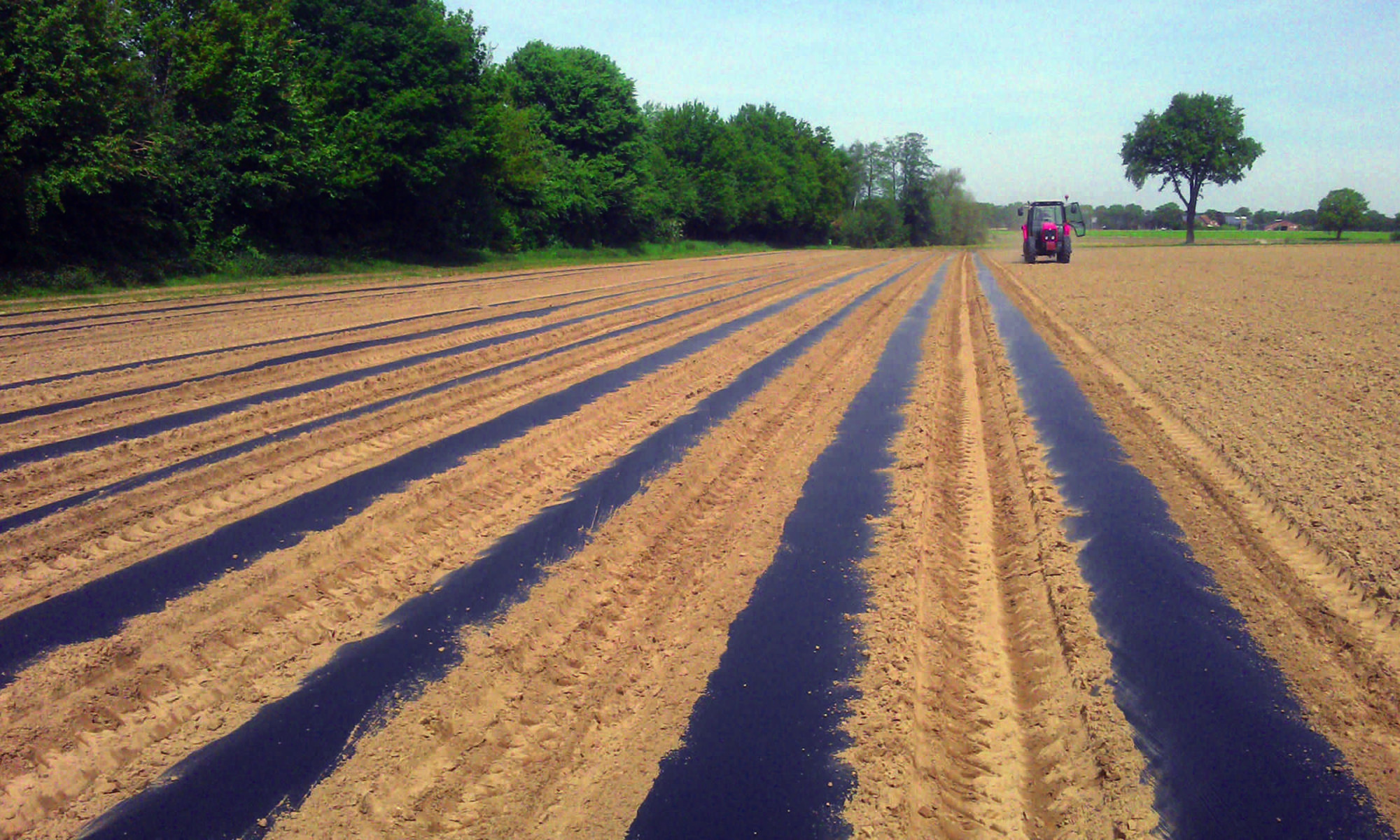PLAAt the moment, plastic mulch films, mostly made from PE, are used increasingly in vegetable, berry and fruit production. Mulches prevent weed growth (and thus limit the use of pesticides), soil erosion and control the temperature and moisture of the soil. Due to its beneficial functionalities in agri- and horticulture, sales of plastic mulch films have been increasing. Most of this material has to be collected before the harvest. because of soil contaminated plastic mulch, recycling or burning for energy purposes is not an option.
Landfilling therefore remains. Not the best solution in terms of the environment, but still better than ploughing the plastic into the soil, a practice by which some farmers aim to save money. Ultimately, these practices reduce soil fertility and endanger local wild life.
Low market share
In most EU-countries, collecting and disposing of plastic mulch film is a labour-intensive and expensive task. Therefore, a biodegradable mulch would not only offer environmental, but also economic benefits.
For the time being, however, the market share of biodegradable products is relatively low, estimated to be lower than 10 per cent of the total volume. This is partly due to the higher price level, 2 to 3 times more expensive, but also partly because these have been mainly developed for small scale, say hobby farming in which these products have to be applied manually. Stora Enso – on the other hand – has developed a mulch paper which can applied mechanically and is therefore suitable for commercial farming purposes, according to the company.
Hurdles
Carl-Mikael Tåg, Team leader Product Development at Stora Enso: ‘We wanted to develop a product not only for a niche market, but for a large market. This meant we had to overcome several hurdles in order to make our mulch paper work in daily farming practices. One issue is the strength and the elasticity of the mulch paper. Most machinery in agriculture has been developed to lay down PE on the soil. Therefore, the settings of the machinery needed to be adjusted in order to avoid ripping of the paper. Last but not least, the preparation of the soil, ploughing in order to make the top surface soft, makes a huge difference.’
According to Tåg, the material is fully biodegradable and based on mechanically refined virgin wood fiber. The coating consists mainly of natural source pigments which are enriching the soil, and a water based dispersion as binder to protect the paper.
Balancing act
Apart from the stability of the mulch paper, the biodegradability proved to be a huge challenge. Quite understandably, as the stability has to be maintained to a certain level, after which the breaking down process should start. ‘It is a tough balancing act’, Tåg says. ‘We have managed to develop our mulch paper which breaks down between 4 to 12 weeks. The key to this transitory process is the fibre mixture while a slow biodegradation is achieved with papers made from mechanical pulp fibres (GW, PGW, TMP) or chemimechanical pulp fibres (CTMP).’
With surface treatment it is also possible to steer the breaking down process. ‘Apart from the product variable, there are natural variables, such as heat, moisture, acidity of the soil, which determine the stability and the biodegradability of mulch paper’, Tåg adds. ‘We have tested various compositions of the mulch paper across Europe, for example in Spain and in Finland, as we wanted to develop a product which is suitable for different climate conditions and/or crops.’
Positive response
In the spring this year, Stora Enso will roll out its mulch paper in Europe, further tests will be held in Asia, the biggest market for this type of product. Tåg is optimistic about the market response. ‘Farmers in general are very interested and willing to adapt their farming practices to suit our product. Yes, our product has a price premium, but we also have investigated the bandwidth we have, compared to PE. In certain markets, for example in Finland, the costs of removal and disposal are relatively high. By saving on these expenses, our mulch paper offers significant cost advantages.’
Peter Janssen grows zucchini and pumpkins on his 50 hectare farm in the province of Limburg in the Netherlands. Janssen previously used PE-foil to protect his zucchini against weed and to keep the plants warm. ‘In the meantime I have switched to PLA-foil, mainly because of reduced costs after usage. Why did I participate in the test with mulch paper? Because I want to be ahead of the competition. The idea of paper appeals to me, as it sounds more environmental-friendly than foil. Mulch paper roughly has the same performance on the field than PLA. The only aspects that needed improvement, was the mechanically laying of the material and the decomposition time. From what I understand, these parameters have been improved by the manufacturer.’
A brief history of mulching
Use of reel paper for mulching started in early 30´s. The use remained limited and practically died down as low cost plastic mulches became available for the farmers in late 50´s. The use of these materials remained wuite low for decades until rapid growth of use started in 80´s.
During 2000-2007, annual world demand of plastic mulch films increased from 0,54 million tons to 1.4 million tons. Most of the mulch films are used in Asia (70 per cent), followed by Europe (13 per cent). Each year, roughly 80.000 km2 of agricultural lands are covered with plastic mulch films. If this area would be covered by paper mulch, this would require 4,8 to 8,0 million tonnes each year, comparable with the total paper and board production in Finland.




Replied on:
Has there been a follow up on the Stora product. Can’t find any.